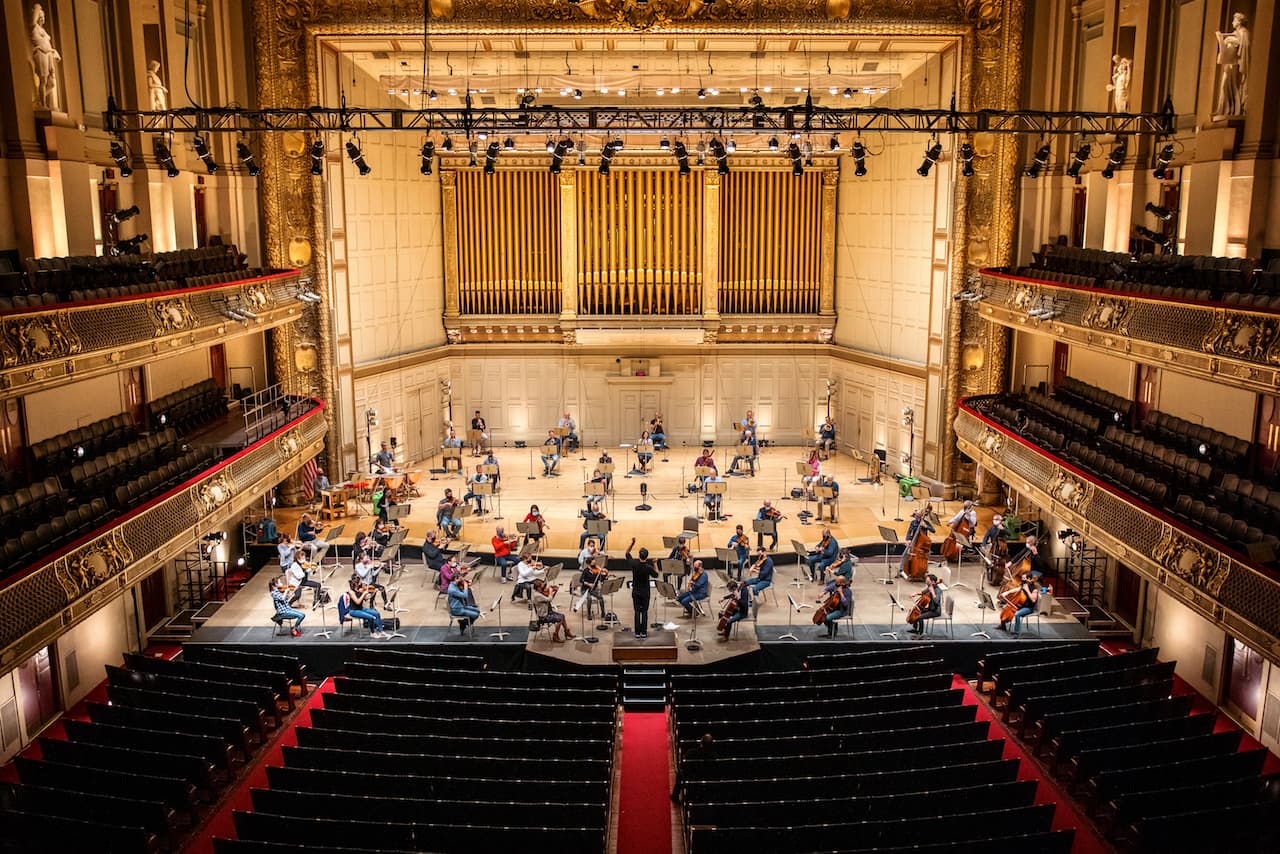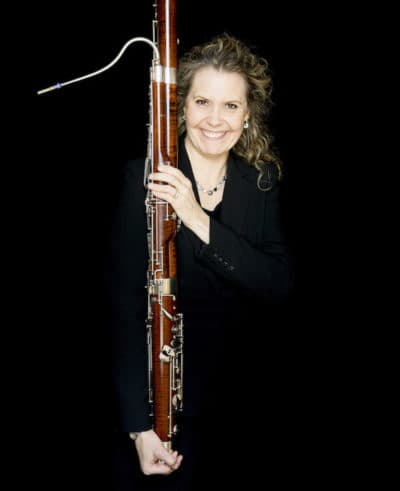Advertisement
BSO Musicians Return To Perform, Without An Audience, In A Very Different Symphony Hall

Boston's iconic Symphony Hall has been dark for more than seven months. But on Wednesday dozens of musicians who call the venue home returned to perform — from a distance and without an audience — for a new series of videos. The content will be released in November as part of the orchestra's upcoming season of virtual programming dubbed BSONOW that's slated to run through April.
Many of us know firsthand how challenging it can be to work from home without our usual desks, computers and colleagues. But imagine your place of employment is a historic, acoustically ideal concert hall where you make music most days of the year together with more than 100 fellow artists.
“It's taken half of my body away from me,” second bassoonist Suzanne Nelsen said of the symphony's time apart. “It's the best job in the world and then you can't express yourself that way.”

She's one of nearly 60 musicians who came back to Symphony Hall to rehearse for the new video performances. Nelsen recalled the last time the orchestra played together at the hall. It was a children's concert in the afternoon on March 12th. Later that day the BSO was sent home.
Nelsen described feeling giddy as she drove to Symphony Hall. She said it felt like the first day of school. When Nelsen walked through the venue's door she said it was totally different then it used to be. “But then sitting on stage and hearing the orchestra – especially the strings – I smiled and even cried a little bit.”
“I mean, even the testing was emotional,” BSO president and CEO Mark Volpe said. Regular COVID-19 screenings are a big part of the stringent, multi-layered set of protocols that's allowing musicians and staff to come back together in the hall. “So the good news is we all tested negative,” Volpe said.
He said the BSO spent upwards of $100,000 to improve air filtration and circulation throughout the 120-year-old building. They consulted with Dr. Joseph Allen to design a rigorous and safe reopening plan. He's an associate professor at the Harvard School of Public Health and founder of 9 Foundations, a healthy buildings company.
Based on determinations made by Allen, architects and other specialists, the performance hall has been reconfigured to ensure players are at least six feet apart. Before the pandemic more than 100 musicians sat somewhat cozily on the famous stage. Now the platform is more than twice its original size thanks to risers the BSO borrowed from its summer home Tanglewood. Rows of seating on the floor have been removed to accommodate the larger stage and the maestro's podium which now sits in a space once occupied by audiences.
“The conductor is probably 70 to 80 feet away from the brass section,” Volpe said. The percussionists are up in the balcony. Players who rely on breath, including Suzanne Nelsen, must have 10 feet between them. She played sitting on the old stage with the strings nearby on the new extension.
“I've been in the orchestra for 20 years, so there's a lot of musical muscle memory,” she said, admitting it was a little lonely being separated from her peers. “We are lucky to have one of the best halls in the world.”
The hall sounded great, Nelsen added, but it felt different without an audience and their applause. That's something the whole orchestra will have to get used to for the foreseeable future.
The musicians were also involved in the safety planning. Volpe said the BSO set up a committee early on made up of staff and one member from every instrument family in the orchestra.
While these changes are being implemented to help keep the musicians engaged, they're also to support the BSO's survival strategy. It rides on creating compelling new virtual experiences to stay connected to audiences. To that end Volpe said they've converted Symphony Hall into a recording studio that's kind of like a soundstage.
“We're not trying to totally simulate the concert experience,” he said. “It's a different approach to how we're organizing our thinking around content.”
Dramatic lighting and 50 mics have been installed through the space, along with 10 robotic cameras. A production crew and engineers are on deck to control the equipment from the studio in Symphony Hall's basement.
The orchestra's on-site performances will anchor the one-hour episodes that also include magazine-style interview segments. Repertoire was selected both for its relationship to the moment we're living through and the number of musicians each piece requires. This means there will not be any Mahler or Shostakovich symphonies this season. “The really huge, hyper-romantic pieces we're just not going to do right now,” Volpe said, “But we're doing Dvorak's 'New World' that doesn't have 10 horns or six trombones or five flutes.”
All of the compositions in the new series, “Music in Changing Times,” need between 13 and 59 players. The first video will include Charles Ives's tune for uncertain times, “The Unanswered Question,” conducted by Ken-David Masur. This will be joined by a chamber music performance of Florence Price's “String Quartet in G.”
The BSO's youths concerts conductor Thomas Wilkins will lead the orchestra in the second episode on Nov. 26th that's programmed with Jessie Montgomery's "Starburst," William Grant Still's "Out of Silence" and Duke Ellington's "New World A-Coming."
The Boston Pops is also recording performances because the annual in-person holiday concerts have been canceled. But Keith Lockhart and the musicians have already filmed some parts of their virtual performances at Fenway Park and will return to the hall in the coming weeks. The usual choruses are not allowed in the building for safety reasons so they'll be singing in their living rooms or basements. “And we'll put together one hundred and fifty (recorded) files and make the chorus come together with the BSO players on stage,” Volpe said.
The BSO is working on the logistics of getting music director Andris Nelsons back to Boston in January for performances that highlight composers who've played a part in changing the world including Beethoven.
In the face of a newly dire economic reality, Volpe said the organization has to transform into a media company. Between March and August, the orchestra lost about $30 million in revenue from ticket sales. Since canceling the 2020-21 winter/spring season and the Holiday Pops, another $21 million have evaporated.
Volpe and the BSO musicians look forward to the days when they can play in front of live audiences again. A hybrid model of digital content and live performances is likely in the cards eventually, but that won't be happening at Symphony Hall anytime soon. Volpe half-joked that there's no way for the BSO to test 2,000 audience members. More seriously – and barring miracles the pubic won't be able to come back until next fall.
